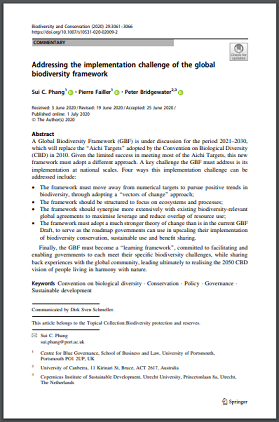
A Global Biodiversity Framework (GBF) is under discussion for the period 2021–2030, which will replace the ‘‘Aichi Targets’’ adopted by the Convention on Biological Diversity (CBD) in 2010. Given the limited success in meeting most of the Aichi Targets, this new framework must adopt a different approach. A key challenge the GBF must address is its implementation at national scales. Four ways this implementation challenge can be addressed include:
- The framework must move away from numerical targets to pursue positive trends in biodiversity, through adopting a ‘‘vectors of change’’ approach;
- The framework should be structured to focus on ecosystems and processes;
- The framework should synergise more extensively with existing biodiversity-relevant global agreements to maximise leverage and reduce overlap of resource use;
- The framework must adopt a much stronger theory of change than is in the current GBF Draft, to serve as the roadmap governments can use in upscaling their implementation of biodiversity conservation, sustainable use and benefit sharing.
Finally, the GBF must become a ‘‘learning framework’’, committed to facilitating and enabling governments to each meet their specific biodiversity challenges, while sharing back experiences with the global community, leading ultimately to realising the 2050 CBD vision of people living in harmony with nature.












